

Hitoyoshi is a 12th-century castle, now ruins, located in Hitoyoshi, Kumamoto Prefecture. It is recognized as one of Japan's top 100 castles. [1]


Hitoyoshi is a 12th-century castle, now ruins, located in Hitoyoshi, Kumamoto Prefecture. It is recognized as one of Japan's top 100 castles. [1]
There was an original castle built on the site by Sagara Nagayori, in the late 1200s. [2] After this, the clan used the castle as their home, up until the early 1400s. Sometime before 1470, another castle was built on the location. [3] The Sagara clan pushed out to extend their power around the Kuma area, however they were defeated by the Shimazu clan at the Battle of Minamata in the year 1581. As a result, they lost much area under their control. [4] [5] Sagara Nagatsune carried out more extensive development of the castle in the year 1589. The Kumagawa River is used by the castle as both an outer defensive moat, and for trade via water transport. The castle was demolished, like many castles in Japan, in the Meiji era.
Little of the castle remains today on site. The stone walls remain extant, with both a recently added yagura and gate. [6]

Hitoyoshi is a city in Kumamoto Prefecture, Japan. The city was founded on February 11, 1942. As of October 2016, the city has an estimated population of 33,461 and a population density of 160 persons per km2. The total area is 210.55 km2.

Kumamoto Castle is a hilltop Japanese castle located in Chūō-ku, Kumamoto, in Kumamoto Prefecture. It was a large and well fortified castle. The castle keep is a concrete reconstruction built in 1960, but several ancillary wooden buildings remain of the original castle. Kumamoto Castle is considered one of the three premier castles in Japan, along with Himeji Castle and Matsumoto Castle. Thirteen structures in the castle complex are designated Important Cultural Property.

The Kyushu Railway Company, also referred to as JR Kyushu, is one of the seven constituent companies of Japan Railways Group. It operates intercity rail services within Kyushu, Japan and the JR Kyushu Jet Ferry Beetle hydrofoil service across the Tsushima Strait between Fukuoka and Busan, South Korea. It also operates hotels, restaurants, and drugstores across its service region. JR Kyushu's headquarters are in Hakata-ku, Fukuoka.
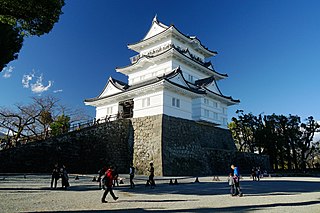
Odawara Castle is a landmark in the city of Odawara in Kanagawa Prefecture, Japan.
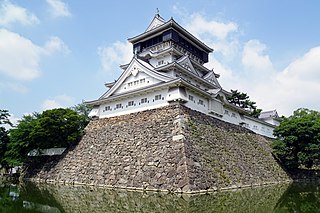
Kokura Castle is a castle in Kitakyushu, Japan. It was built by Hosokawa Tadaoki starting in 1602, with construction completed in 1608.
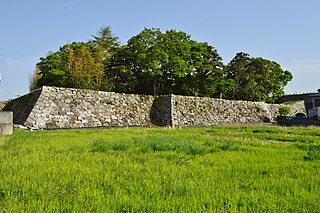
Obama Castle was a seaside-style castle located in what is now the city of Obama, Fukui Prefecture, Japan. During the Edo period, it was the headquarters of a junior branch of the Sakai clan, who were hereditary daimyō of Obama Domain under the Tokugawa shogunate. The castle was also known by the name of Unpin Castle.

The Hitoyoshi Domain was a Japanese domain of the Edo period. It was associated with Higo Province in modern-day Kumamoto Prefecture.

Aoi Aso Shrine is a Shinto shrine in Hitoyoshi, Kumamoto Prefecture, Japan. It is colloquially known as Aoi-san (青井さん). It was originally established as a prefectural shrine, but is currently designated as a national shrine. Five of the structures within the shrine are listed as National Treasures of Japan.
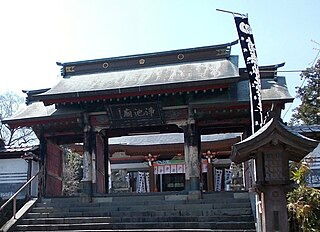
Honmyō-ji (本妙寺) is a Buddhist temple of the Nichiren sect, Rokujōmon-ryū (六条門流), in Nishi-ku, Kumamoto, Japan. It is the most high-ranking temple of the sect in Kyushu. In Honmyō-ji is the grave of Katō Kiyomasa, (1562–1611), a Japanese daimyō, builder of Kumamoto Castle and a dedicated buddhist of Nichiren Buddhism.
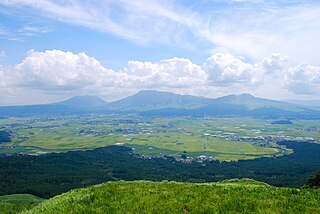
The history of Kumamoto Prefecture has been documented from paleolithic times to the present. Kumamoto Prefecture is the eastern half of Hinokuni, and corresponds to what was once called Higo Province. Exceptions are the part of Kuma District, which had once been part of Sagara Domain, and Nagashima which was included in Kagoshima Prefecture.

The Sagara clan was a Japanese samurai clan of daimyos. They were a tactical ally of the Shimazu clan.
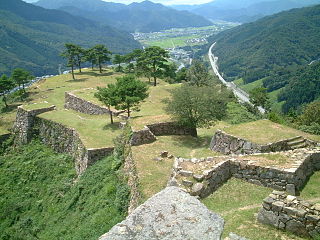
Takeda Castle was a Sengoku period Japanese castle located in the Wadayama neighborhood of the city of Asago, in the northern part of Hyōgo Prefecture, Japan. It is located north of Himeji, and north-west of Kyoto, and is situated some 353 metres above sea level It is often referred to locally as the "Machu Picchu of Japan". Its ruins have been protected as a National Historic Site since 1943.

Sakura Castle was a 17th-century castle, now in ruins, in Sakura, Chiba Prefecture. It was designated one of Japan's Top 100 Castles by the Japanese Castle Foundation.

Tsuwano Castle was a mid-size castle, now ruins, in Tsuwano, Shimane Prefecture, Japan.

Tsutsujigasaki Castle was the fortified residence of the final three generations of the Takeda clan, located in the center of the city of Kōfu, Yamanashi Prefecture, Japan. It is not a Japanese castle in the proper sense of the word, and is not referred to as a "castle" in Japanese, as it was famously the policy of the Takeda clan to "make men your castle, men your walls, men your moats". Nevertheless, it is listed as one of Japan's Top 100 Castles. The ruins have been protected as a National Historic Site since 1938. The site is open to the public and now contains the Takeda Shrine, a Shinto shrine dedicated to the deified spirits of the Takeda clan.
Takatori Castle was a 14th-century Japanese castle, now in ruins, in Takatori, Nara Prefecture.

Mito Castle was a 12th-century Japanese castle with an extensive history, now in ruins, located in what was Hitachi Province. The castle ruins are located in the city of Mito, Ibaraki Prefecture, Japan.
Marume Nagayoshi was a retainer of the Sagara clan in the Sengoku period and a swordsman in the early Edo period. He was considered one of the best pupils of Kamiizumi Nobutsuna, and went on to found the Taisha ryū school. He was sometimes known as Kurandonosuke and also as Ishimi Mamoru, but was best known as Marume Nagayoshi, which he was called in kōdan. His original name was Fujiwara, and his art name was Tessai. In his later years he shaved his head and went by the name of Ishimi Nyūdō Tessai.

Ichinomiya Castle is a mountaintop castle in Tokushima, Japan.

The Ogasawara clan castle sites were a number Sengoku period yamashiro-style Japanese castles located in what is now part of the city of Matsumoto, Nagano prefecture. These fortifications were built in the Muromachi period by the Ogasawara clan, who ruled the area at the time. Two of the castle ruins, that of Igawa Castle and Hayashi Castle, have been protected collectively as a National Historic Sites since 2017.
Coordinates: 32°12′39.9″N130°45′59.37″E / 32.211083°N 130.7664917°E